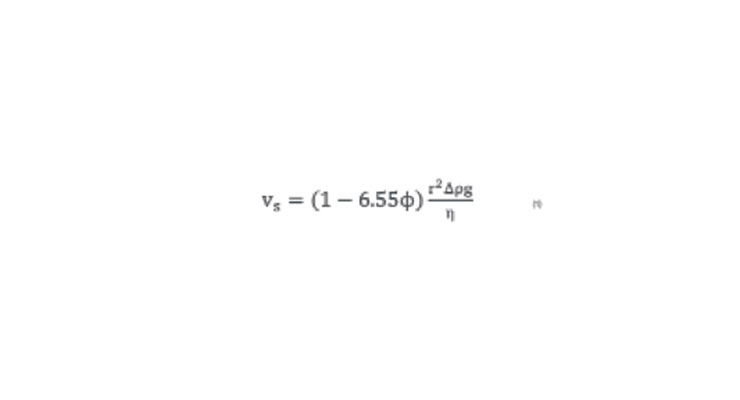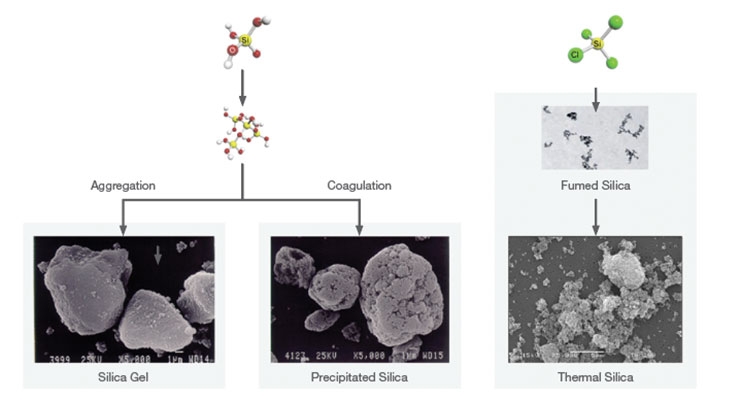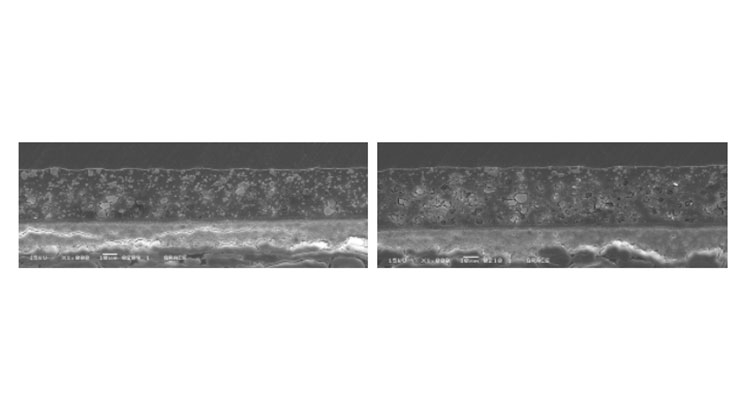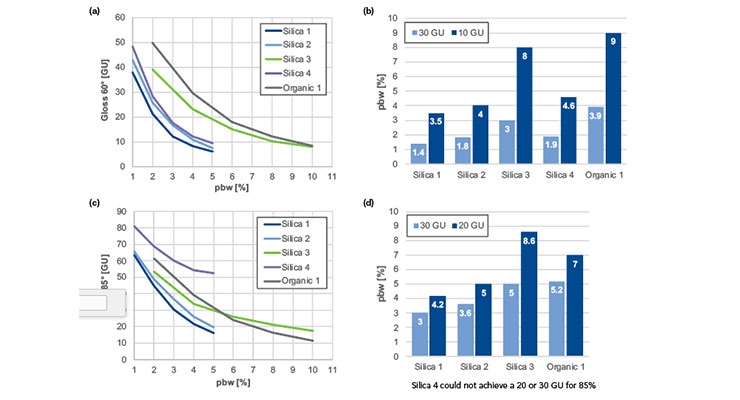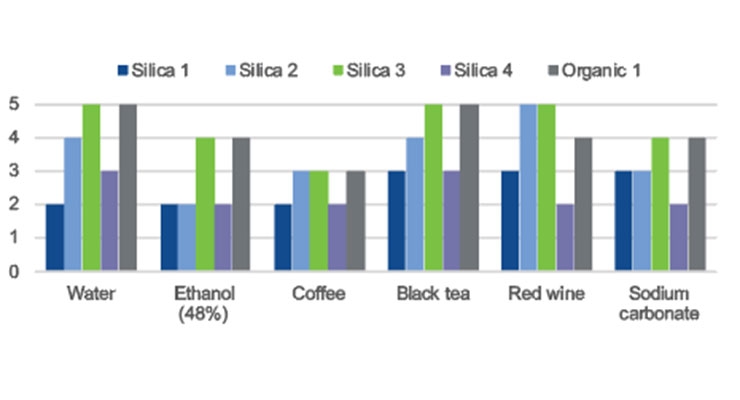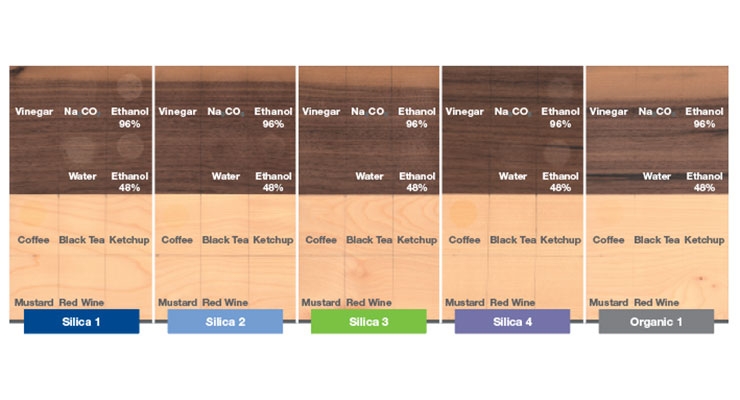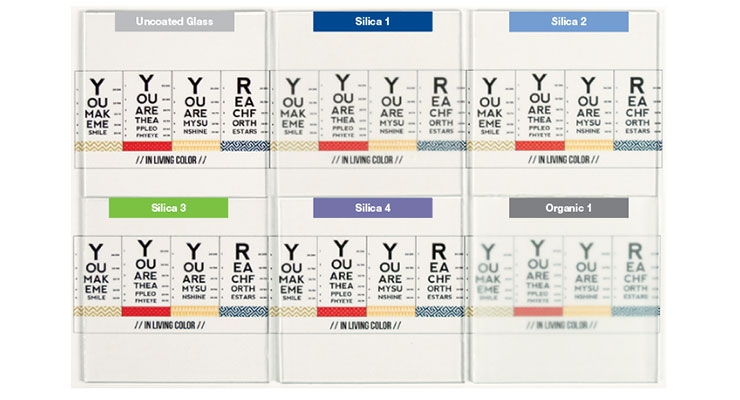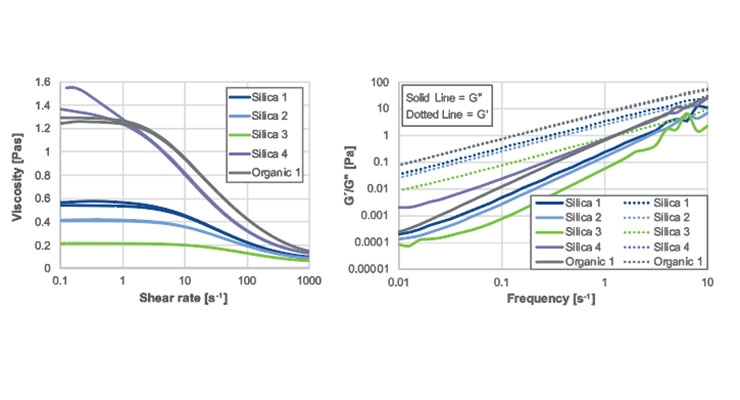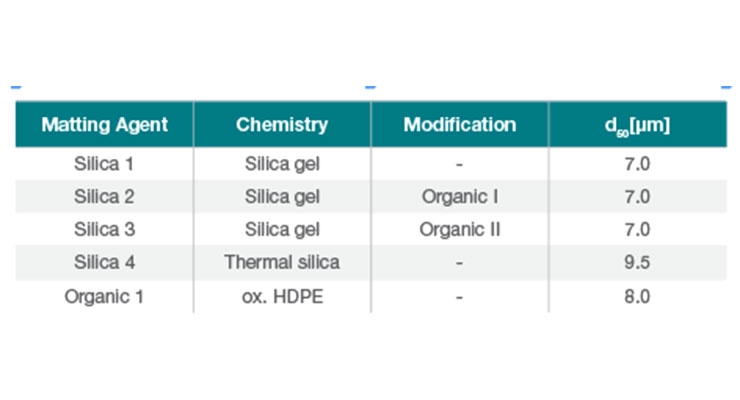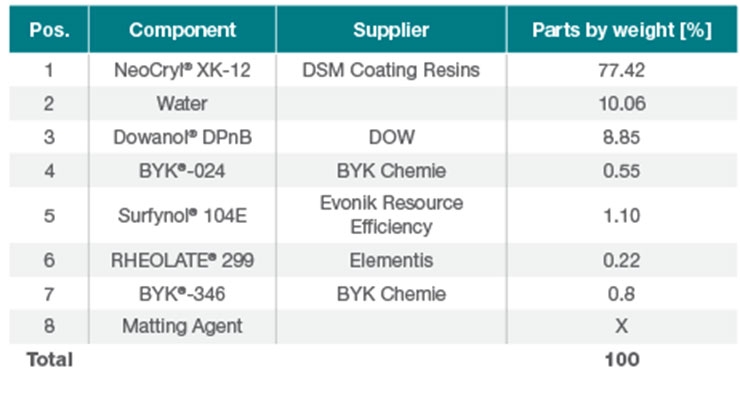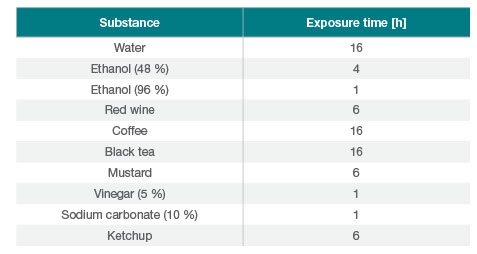Alexander Kröger, Matthias Märcz, Steve Broadwater, Feng Gu, W. R. Grace02.19.20
Introduction
Modern waterborne industrial coatings require the highest standards in performance and quality. A majority of the finishes are currently semi-gloss, but there is a trend towards deep-matte and natural-looking coatings. One-pack acrylic/polyurethane coatings are a steadily growing technology in this segment because of the easy handling and economic advantage over two-pack systems. However, the development of deep-matte waterborne coatings, especially one-pack, remains a challenge because of loss-of-film properties such as chemical resistance, transparency, and mechanical integrity.
Approximately 80% of all waterborne wood coatings contain silica-based matting agents to enhance the aesthetic appeal to customers, as well as offer protection to the wood. Silica offers several advantages as a matting agent including various morphologies, structural and charge properties. The goal of this publication is to highlight the impact of matting agents on the performance of waterborne industrial wood coatings, and to present a new concept of silica matting agents for these formulations.
Background
Silica Technologies for Matting Agent Production
Silica matting agents are available in various sizes and shapes. In general, silica matting agents consist of relatively large silicon dioxide particles with average particle diameters well above 1 µm. There are three main commercial technologies (Figure 1) that lead to silica with different morphologies:
• Silica gel particles are solid, shear-stable matting agents with a highly defined pore structure and a narrow pore
size distribution;
• Precipitated silica is less shear-stable and has a considerably wider pore size distribution than silica gel; and
• Thermal silicas are hybrid silicas made from fumed silica with large pores, low density and low shear stability.
The three silica types impact the matting efficiency, chemical resistance, transparency, rheology, and burnishing resistance. Silica matting agents exhibit excellent matting efficiency. However, it tends to degrade the performance of the coating in terms of its chemical and mechanical resistance. In order to alleviate the performance disadvantages of the silica-based matting agents, organic matting agents are used. Organic matting agents commonly have low matting efficiency.
The following discussion describes the development of silica-based matting agents that not only provide high matting efficiency, but also offer exceptional chemical and burnishing resistance.
Matting Efficiency
The matting efficiency of silica matting agents is determined by several product and coating parameters. The main factor that determines the matting agent’s coating efficiency is the particle volume concentration. Higher concentration causes increased micro-roughness of the surface, leading to a lower gloss level. Increasing the concentration of silica particles can be achieved by simply adding more matting agent or by choosing a grade with higher pore volume. The higher pore volume yields less dense particles and hence more particles per unit mass.
The second factor is the particle size distribution. For a given film thickness, larger particles have a higher probability to alter the surface roughness. However, particles that are too large can easily lead to tangible roughness, which is generally undesirable. Thermal silicas present a special class of matting agents. These particles are condensed fumed silica particles. The lower silanol density of the fumed silica particles results in lower shear stability. High shear force during dispersion breaks up the silica particles which will, depending on concentration, percolate and form a random network consisting of particles and reticular structures.2,3 This structure yields low gloss (60° gloss) due to particles perturbing the surface and subsurface scattering, but lacks sheen behavior (85° gloss).
Chemical Resistance
To guarantee that a coating used for interiors is not susceptible to visual alteration during use, lacquers are tested for chemical resistance. Test substances for interior wood coatings are based on the actual everyday use and commonly include water, alcohol, coffee, and other tinting substances. Depending on the chemical characteristics of the chemical, the mechanism by which the coating is impaired differs significantly.
One-pack acrylic clearcoats generally allow water vapor diffusion throughout the film. As water penetrates the coating surface it forms domains, which lead to substantial turbidity. In a glossy clearcoat the absorbed water will eventually evaporate, returning the coating to its transparent appearance.1 This penetration/evaporation mechanism of clearcoats is significantly altered if the coating contains porous silica-based matting agents. The highly porous structure of the silica entraps the absorbed water and substantially slows down the evaporation. Furthermore, when the silica is in contact with water it undergoes structural reorganization. This reorganization ultimately leads to shrinking of the silica particles and development of microcracks between the silica surface and the polymer matrix (Figure 2b). These newly formed cracks are large enough to scatter light, leading to the well-known hazy appearance after water exposure. Due to its structural features, the effect is dampened with thermal silica compared to robust silica gels or precipitates.
Rheology
Settling Behavior
Silica matting agents are relatively large particles with average particle diameters well above 1 µm. In contrast to submicron particles which are dominated by Brownian motion, this property makes them susceptible to sedimentation in Newtonian liquids. The sedimentation velocity is directly impacted by the particle diameter, or radius r, the density difference between the particle and the bulk medium Δρ, the zero-shear viscosity η and the packing factor ϕ (equation 1).
Although sedimentation can happen quite quickly, settling of silica particles in the form of a solid, hard to redisperse sediment rarely occurs in waterborne lacquers. Redispersion requires only low shear force.
Application Properties
Silicas have unique structures and are amphiphilic. Their structural and charge properties allow silicas to interact with mid- and high-shear associative thickeners. The extent of interaction strongly depends on the chemical nature of the thickener. Hydrophobically modified ethylene oxide urethane (HEUR) thickeners are widely used because of their reliable flow behavior and good color retention. However, in the presence of silicas, HEUR cannot undergo its thickening mechanism because the ethylene oxide backbone adsorbs to silica. The altered rheological profile can lead to poor application properties, e.g., increased overspray. Adding more thickener or replacing with other thickeners, like HASE or NSAT, are two ways to counteract this behavior. The effect is observed with every silica technology. However, thermal silicas, due to their morphological nature, tend to counteract by increasing the low-
shear viscosity.
Burnishing
In contrast to solventborne coatings, burnishing is one of the biggest disadvantages of the matted waterborne coatings. Mechanical wear causes the gloss of the matted surface to increase significantly. The origin of the effect is complex and depends on several factors, including the desired gloss level, the characteristics of the binder, and the matting agent. Generally, the burnishing tendency increases with decreasing gloss level. The tendency of silica to cause burnishing depends on the chemical and physical nature of the matting agent. Untreated silica grades show a high tendency to cause burnishing while an organic wax treatment can yield significant improvements due to reinforcement of the silica structure. Exceeding a certain threshold decreases the burnishing resistance because the wax overloads and spreads between the micro-rough surface features. Thermal silicas are highly susceptible to burnishing because of their shear instability.
Experimental
Materials and Sample Preparation
All raw materials were used as supplied. The two new silica grades, 2 and 3, were compared to two commercially available silicas, 1 and 4, as well as with an organic matting agent (Table 1).
The test formulation in which the silicas were analyzed was based on NeoCryl® XK-12, an ambient self-crosslinking acrylic dispersion for interior wood finishes. The matting agents were dispersed (6 m/s, 10 min) into the finished base lacquer (Table 2). Films were applied to both black test cards and wooden substrates (100 g/m²).
Analytical Techniques
The liquid lacquer samples were characterized for their defoaming properties and their rheological profiles. Defoaming was determined photographically. Rheological (Malvern Panalytical, Kinexus® pro+, CR-test (0.1 – 300 – 0.1 s-1) and frequency sweep measurements (0.1 Pa, 10 – 0.01 s-1) were conducted to determine the impact of the matting agents on settling behavior and application properties. The lacquers were applied (spiral blade drawdown, 100 µm, 7 d drying) to black Leneta cards for matting efficiency and burnishing testing; they were also applied to multi-wood panels made from walnut and maple (spray application, 2 x 50 µm wet, 7 d drying) for chemical- resistance testing.
Chemical-resistance testing was done at 10 GU (60°) according to DIN 68861-1 / DIN EN 12720. Test substances and exposure times were chosen to fit the application profile of furniture or kitchen cabinet surfaces (Table 3). Burnishing tests were conducted with the modified TABER® ABRASER® method (TABER® ABRASER 5131, sample holder E 100-125, Scotch-Brite™ fiber fleece 7498 F-SFN, 200 cycles). Chemical resistance ratings (DIN 68861-1) are shown in Table 4.
Results and Discussion
Matting Efficiency
Industrial waterborne wood coatings are commonly applied with an application weight between 80 and 120 g/m². The optimum average particle diameter for these systems was between 6.5 and 8.5 µm. The optimum range was found by balancing the solid content and the average film shrinkage caused by coalescence and interdiffusion to the achievable fineness of grind of a matting agent. This rule held for shear-stable silica gel and hybrid silicas. The approximation was not valid for thermal silica grades because of their lack of shear stability and the percolation behavior.
The matting curves at 60° measuring angle and the resulting efficiencies were comparable for Silica 1, 2 and 4. Silica 3 and Organic 1 had comparable efficiencies (Figure 3). The efficiency situation at the 85° measuring angle was different. The thermal silica grade showed a lack of sheen control. The material was not suitable for semi-matte and matte finishes at the 85° measuring angle. All silica gel grades showed a similar behavior at high-angle measurements.
Chemical Resistance
At 10 GU, Silica 3 and Organic 1 yielded the best chemical resistance against all tested substances (Figure 4). Silica 2 and 4 offered good chemical resistance. Silica 1 yielded poor results. Compared to other commercially available silica matting agents, the two new products, Silica 2 and 3, showed improvements in water, coffee and red-wine resistance. The novel organic treatment of Silica 2 and 3 prevented the penetration of the pore structure by water and chemicals.
Transparency
Silica matting agents sometimes cause haze in waterborne clear lacquers. The problem is most noticeable on dark wood types, such as walnut. The physical cause is air trapped in the particles’ porous silica structure. During the drying process, the large particles in the polymeric dispersion particles (40 – 120 nm diameter) cannot replace the evaporating water. The transparency of the matted coating can be increased by minimizing the inaccessible pore volume. Silica 2, 3 and 4 yielded high transparencies. The untreated Silica 1 and Organic 1 caused a significant haze (Figure 6).
Burnishing
Compared to the other grades, Silica 2, Silica 3 and Organic 1 showed a significant improvement in burnishing resistance (Figure 7). Silica 1 and 4 showed a high burnishing tendency.
The results agree with the theory: the untreated silica gel grade as well as the thermal silica grade show poor behavior while the organically treated grades demonstrated good performance.
Rheology
All silica gel grades have a strong impact on the viscosity profile (Figure 8). The organic treatment of silica 2 and 3 decreased the viscosity more strongly than the untreated grade. The formulation only contained HEUR thickeners that readily adsorb to the silica surface. The effect also occurred with thermal silica. However, the newly formed fumed silica particles increased the viscosity in the low- and mid-shear regions. The organic matting agent yielded a similar rheology profile as that of the fumed silica. Care should be taken in the selection of the rheology package when formulating waterborne coatings to the desired viscosity profile.
The frequency sweep showed that the lacquers behave like viscoelastic liquids. Silica 1, 2 and 3 followed the same trend in the rheology profile. Silica 4 caused an increase in elastic modulus which agrees with the proposed mechanism.
Summary and Conclusion
Performance improvements are needed in deep-matte industrial wood coatings based on one-pack waterborne acrylics and acrylic/PUD for this technology to find widespread utility in the marketplace. Extensive studies have shown that the combination of silica-particle design and selection of organic treatment can result in matting agents that improve film performance in these formulations. Specifically, these newly designed materials based on mechanically robust silica gels can enable improvements in chemical- and stain-resistance, burnishing resistance and film transparency. In addition, the inherent nature of these particles significantly reduces film sheen and provides a higher degree of gloss uniformity across wide range of viewing angles.
Silica 2 provides the best overall performance with excellent matting efficiency as well as high chemical resistance, transparency, and burnishing resistance. Silica 3 exhibits outstanding chemical resistance and transparency while maintaining good matting efficiency. Both grades will provide formulators an additional tool to meet the ever-growing performance needs of waterborne coatings.
References
1. Dragnevski, K.I., et al., Coll. Surf. A, 317 (2008), 551-556
2. Royall, C.P., et al., Langmuir, 18 (2002), 9519-9526
3. Royall, C.P., et al., Phys. Rev. E, 66 (2002), 021406
Modern waterborne industrial coatings require the highest standards in performance and quality. A majority of the finishes are currently semi-gloss, but there is a trend towards deep-matte and natural-looking coatings. One-pack acrylic/polyurethane coatings are a steadily growing technology in this segment because of the easy handling and economic advantage over two-pack systems. However, the development of deep-matte waterborne coatings, especially one-pack, remains a challenge because of loss-of-film properties such as chemical resistance, transparency, and mechanical integrity.
Approximately 80% of all waterborne wood coatings contain silica-based matting agents to enhance the aesthetic appeal to customers, as well as offer protection to the wood. Silica offers several advantages as a matting agent including various morphologies, structural and charge properties. The goal of this publication is to highlight the impact of matting agents on the performance of waterborne industrial wood coatings, and to present a new concept of silica matting agents for these formulations.
Background
Silica Technologies for Matting Agent Production
Silica matting agents are available in various sizes and shapes. In general, silica matting agents consist of relatively large silicon dioxide particles with average particle diameters well above 1 µm. There are three main commercial technologies (Figure 1) that lead to silica with different morphologies:
• Silica gel particles are solid, shear-stable matting agents with a highly defined pore structure and a narrow pore
size distribution;
• Precipitated silica is less shear-stable and has a considerably wider pore size distribution than silica gel; and
• Thermal silicas are hybrid silicas made from fumed silica with large pores, low density and low shear stability.
The three silica types impact the matting efficiency, chemical resistance, transparency, rheology, and burnishing resistance. Silica matting agents exhibit excellent matting efficiency. However, it tends to degrade the performance of the coating in terms of its chemical and mechanical resistance. In order to alleviate the performance disadvantages of the silica-based matting agents, organic matting agents are used. Organic matting agents commonly have low matting efficiency.
The following discussion describes the development of silica-based matting agents that not only provide high matting efficiency, but also offer exceptional chemical and burnishing resistance.
Matting Efficiency
The matting efficiency of silica matting agents is determined by several product and coating parameters. The main factor that determines the matting agent’s coating efficiency is the particle volume concentration. Higher concentration causes increased micro-roughness of the surface, leading to a lower gloss level. Increasing the concentration of silica particles can be achieved by simply adding more matting agent or by choosing a grade with higher pore volume. The higher pore volume yields less dense particles and hence more particles per unit mass.
The second factor is the particle size distribution. For a given film thickness, larger particles have a higher probability to alter the surface roughness. However, particles that are too large can easily lead to tangible roughness, which is generally undesirable. Thermal silicas present a special class of matting agents. These particles are condensed fumed silica particles. The lower silanol density of the fumed silica particles results in lower shear stability. High shear force during dispersion breaks up the silica particles which will, depending on concentration, percolate and form a random network consisting of particles and reticular structures.2,3 This structure yields low gloss (60° gloss) due to particles perturbing the surface and subsurface scattering, but lacks sheen behavior (85° gloss).
Chemical Resistance
To guarantee that a coating used for interiors is not susceptible to visual alteration during use, lacquers are tested for chemical resistance. Test substances for interior wood coatings are based on the actual everyday use and commonly include water, alcohol, coffee, and other tinting substances. Depending on the chemical characteristics of the chemical, the mechanism by which the coating is impaired differs significantly.
One-pack acrylic clearcoats generally allow water vapor diffusion throughout the film. As water penetrates the coating surface it forms domains, which lead to substantial turbidity. In a glossy clearcoat the absorbed water will eventually evaporate, returning the coating to its transparent appearance.1 This penetration/evaporation mechanism of clearcoats is significantly altered if the coating contains porous silica-based matting agents. The highly porous structure of the silica entraps the absorbed water and substantially slows down the evaporation. Furthermore, when the silica is in contact with water it undergoes structural reorganization. This reorganization ultimately leads to shrinking of the silica particles and development of microcracks between the silica surface and the polymer matrix (Figure 2b). These newly formed cracks are large enough to scatter light, leading to the well-known hazy appearance after water exposure. Due to its structural features, the effect is dampened with thermal silica compared to robust silica gels or precipitates.
Rheology
Settling Behavior
Silica matting agents are relatively large particles with average particle diameters well above 1 µm. In contrast to submicron particles which are dominated by Brownian motion, this property makes them susceptible to sedimentation in Newtonian liquids. The sedimentation velocity is directly impacted by the particle diameter, or radius r, the density difference between the particle and the bulk medium Δρ, the zero-shear viscosity η and the packing factor ϕ (equation 1).
Although sedimentation can happen quite quickly, settling of silica particles in the form of a solid, hard to redisperse sediment rarely occurs in waterborne lacquers. Redispersion requires only low shear force.
Application Properties
Silicas have unique structures and are amphiphilic. Their structural and charge properties allow silicas to interact with mid- and high-shear associative thickeners. The extent of interaction strongly depends on the chemical nature of the thickener. Hydrophobically modified ethylene oxide urethane (HEUR) thickeners are widely used because of their reliable flow behavior and good color retention. However, in the presence of silicas, HEUR cannot undergo its thickening mechanism because the ethylene oxide backbone adsorbs to silica. The altered rheological profile can lead to poor application properties, e.g., increased overspray. Adding more thickener or replacing with other thickeners, like HASE or NSAT, are two ways to counteract this behavior. The effect is observed with every silica technology. However, thermal silicas, due to their morphological nature, tend to counteract by increasing the low-
shear viscosity.
Burnishing
In contrast to solventborne coatings, burnishing is one of the biggest disadvantages of the matted waterborne coatings. Mechanical wear causes the gloss of the matted surface to increase significantly. The origin of the effect is complex and depends on several factors, including the desired gloss level, the characteristics of the binder, and the matting agent. Generally, the burnishing tendency increases with decreasing gloss level. The tendency of silica to cause burnishing depends on the chemical and physical nature of the matting agent. Untreated silica grades show a high tendency to cause burnishing while an organic wax treatment can yield significant improvements due to reinforcement of the silica structure. Exceeding a certain threshold decreases the burnishing resistance because the wax overloads and spreads between the micro-rough surface features. Thermal silicas are highly susceptible to burnishing because of their shear instability.
Experimental
Materials and Sample Preparation
All raw materials were used as supplied. The two new silica grades, 2 and 3, were compared to two commercially available silicas, 1 and 4, as well as with an organic matting agent (Table 1).
The test formulation in which the silicas were analyzed was based on NeoCryl® XK-12, an ambient self-crosslinking acrylic dispersion for interior wood finishes. The matting agents were dispersed (6 m/s, 10 min) into the finished base lacquer (Table 2). Films were applied to both black test cards and wooden substrates (100 g/m²).
Analytical Techniques
The liquid lacquer samples were characterized for their defoaming properties and their rheological profiles. Defoaming was determined photographically. Rheological (Malvern Panalytical, Kinexus® pro+, CR-test (0.1 – 300 – 0.1 s-1) and frequency sweep measurements (0.1 Pa, 10 – 0.01 s-1) were conducted to determine the impact of the matting agents on settling behavior and application properties. The lacquers were applied (spiral blade drawdown, 100 µm, 7 d drying) to black Leneta cards for matting efficiency and burnishing testing; they were also applied to multi-wood panels made from walnut and maple (spray application, 2 x 50 µm wet, 7 d drying) for chemical- resistance testing.
Chemical-resistance testing was done at 10 GU (60°) according to DIN 68861-1 / DIN EN 12720. Test substances and exposure times were chosen to fit the application profile of furniture or kitchen cabinet surfaces (Table 3). Burnishing tests were conducted with the modified TABER® ABRASER® method (TABER® ABRASER 5131, sample holder E 100-125, Scotch-Brite™ fiber fleece 7498 F-SFN, 200 cycles). Chemical resistance ratings (DIN 68861-1) are shown in Table 4.
Results and Discussion
Matting Efficiency
Industrial waterborne wood coatings are commonly applied with an application weight between 80 and 120 g/m². The optimum average particle diameter for these systems was between 6.5 and 8.5 µm. The optimum range was found by balancing the solid content and the average film shrinkage caused by coalescence and interdiffusion to the achievable fineness of grind of a matting agent. This rule held for shear-stable silica gel and hybrid silicas. The approximation was not valid for thermal silica grades because of their lack of shear stability and the percolation behavior.
The matting curves at 60° measuring angle and the resulting efficiencies were comparable for Silica 1, 2 and 4. Silica 3 and Organic 1 had comparable efficiencies (Figure 3). The efficiency situation at the 85° measuring angle was different. The thermal silica grade showed a lack of sheen control. The material was not suitable for semi-matte and matte finishes at the 85° measuring angle. All silica gel grades showed a similar behavior at high-angle measurements.
Chemical Resistance
At 10 GU, Silica 3 and Organic 1 yielded the best chemical resistance against all tested substances (Figure 4). Silica 2 and 4 offered good chemical resistance. Silica 1 yielded poor results. Compared to other commercially available silica matting agents, the two new products, Silica 2 and 3, showed improvements in water, coffee and red-wine resistance. The novel organic treatment of Silica 2 and 3 prevented the penetration of the pore structure by water and chemicals.
Transparency
Silica matting agents sometimes cause haze in waterborne clear lacquers. The problem is most noticeable on dark wood types, such as walnut. The physical cause is air trapped in the particles’ porous silica structure. During the drying process, the large particles in the polymeric dispersion particles (40 – 120 nm diameter) cannot replace the evaporating water. The transparency of the matted coating can be increased by minimizing the inaccessible pore volume. Silica 2, 3 and 4 yielded high transparencies. The untreated Silica 1 and Organic 1 caused a significant haze (Figure 6).
Burnishing
Compared to the other grades, Silica 2, Silica 3 and Organic 1 showed a significant improvement in burnishing resistance (Figure 7). Silica 1 and 4 showed a high burnishing tendency.
The results agree with the theory: the untreated silica gel grade as well as the thermal silica grade show poor behavior while the organically treated grades demonstrated good performance.
Rheology
All silica gel grades have a strong impact on the viscosity profile (Figure 8). The organic treatment of silica 2 and 3 decreased the viscosity more strongly than the untreated grade. The formulation only contained HEUR thickeners that readily adsorb to the silica surface. The effect also occurred with thermal silica. However, the newly formed fumed silica particles increased the viscosity in the low- and mid-shear regions. The organic matting agent yielded a similar rheology profile as that of the fumed silica. Care should be taken in the selection of the rheology package when formulating waterborne coatings to the desired viscosity profile.
The frequency sweep showed that the lacquers behave like viscoelastic liquids. Silica 1, 2 and 3 followed the same trend in the rheology profile. Silica 4 caused an increase in elastic modulus which agrees with the proposed mechanism.
Summary and Conclusion
Performance improvements are needed in deep-matte industrial wood coatings based on one-pack waterborne acrylics and acrylic/PUD for this technology to find widespread utility in the marketplace. Extensive studies have shown that the combination of silica-particle design and selection of organic treatment can result in matting agents that improve film performance in these formulations. Specifically, these newly designed materials based on mechanically robust silica gels can enable improvements in chemical- and stain-resistance, burnishing resistance and film transparency. In addition, the inherent nature of these particles significantly reduces film sheen and provides a higher degree of gloss uniformity across wide range of viewing angles.
Silica 2 provides the best overall performance with excellent matting efficiency as well as high chemical resistance, transparency, and burnishing resistance. Silica 3 exhibits outstanding chemical resistance and transparency while maintaining good matting efficiency. Both grades will provide formulators an additional tool to meet the ever-growing performance needs of waterborne coatings.
References
1. Dragnevski, K.I., et al., Coll. Surf. A, 317 (2008), 551-556
2. Royall, C.P., et al., Langmuir, 18 (2002), 9519-9526
3. Royall, C.P., et al., Phys. Rev. E, 66 (2002), 021406

